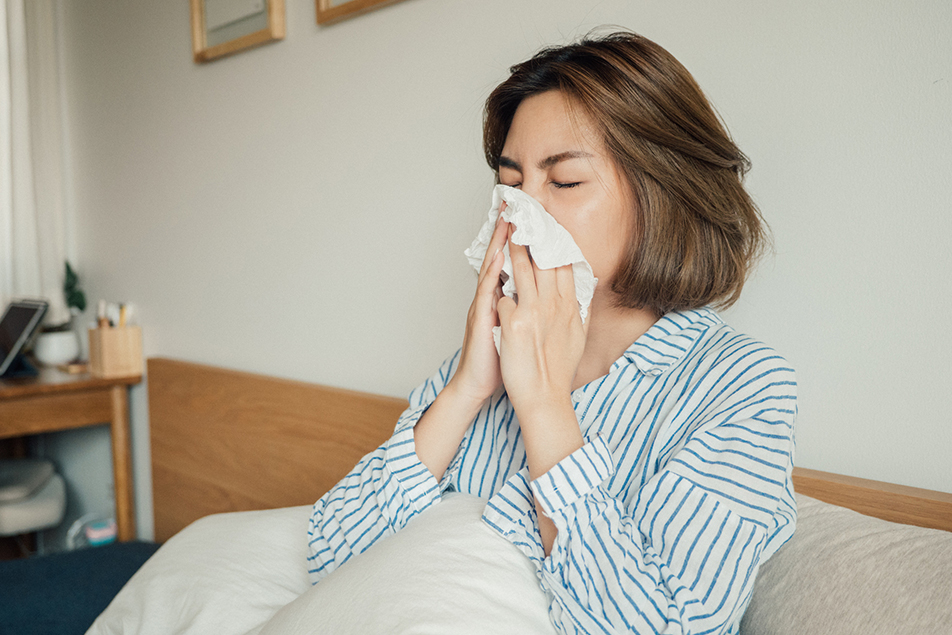
This post was written by Heather Willison, MSN, FNP-C, PPG – Allergy, Asthma and Immunology.
A runny, stuffy nose may not only cause trouble during the day, but it may also make it difficult to sleep at night.
When you encounter an allergen, your body is triggered to release a chemical called histamine. This histamine release results in increased mucous production, swelling of the nasal passages and sneezing. This combination of factors causes the nasal passages to narrow, which in turn makes it difficult to breathe through the nose. Most people find it next to impossible to sleep through the night with a stuffy, congested nose. Unfortunately, a lack of sleep can lead to other issues, such as irritability, decreased productivity, fatigue and memory problems.
So, what environmental factors, both indoor and outdoor, can lead to allergy symptoms, and how do we tackle these pesky allergens?
Dust mites
Dust mites are the most common trigger for allergy symptoms. These are microscopic little critters that live in our mattresses, pillows, carpets and upholstered furniture. Since we spend a great deal of time sleeping, it’s important to implement dust mite control measures in the bedroom.
- Encase mattresses, box springs and pillows in special allergen-proof fabric covers .
- Bedding should be washed weekly in hot water or dried on high heat.
- Dust mites thrive in a moist environment, so keep humidity low by using a dehumidifier or air conditioning.
- If not a financial burden, wall-to-wall carpeting should be removed as much as possible. If not possible, vacuum twice weekly using a vacuum with a HEPA (high-efficiency particulate air) filter or a double-layered bag.
Pet dander
It’s estimated that 10% of the population has allergies to pets. Unfortunately, hypoallergenic pets don’t exist regardless of claims made by breeders. The allergic symptoms people may experience when around animals is triggered by a protein that is found in the skin (dander), saliva and urine of the animal. While some pets do produce less of this protein, there is no scientific evidence available that supports one breed over another.
- Keep pets out of the bedroom when possible, and wash linens in hot water weekly.
- Train pets to stay off the furniture; consider placing aluminum foil on the couch as a deterrent.
- Brush and bathe them frequently (this should be done by another family member, preferably outdoors).
- Vacuum twice weekly, and consider replacing carpet with hard surface flooring.
- Consider investing in a HEPA (high efficiency particulate air) filter to trap dander.
Indoor molds
Indoor mold and mildew can be found in damp environments, such as basements or bathrooms. The use of a dehumidifier and air conditioning can help reduce humidity in the home, and you should use an exhaust fan when showering. Mold and mildew may also be present anywhere there is a water leak.
- Mold found on hard surfaces should be promptly cleaned using a 5% bleach solution.
- If an item cannot be cleaned properly, toss it in the trash.
- It is important to find and promptly repair any leaks.
Pollens
While pollens aren’t indoor allergens, we certainly invite them inside our homes on our clothing and when we open windows. In the Midwest, we see a rise in tree pollen from March until late May. Grass pollen counts are elevated from May until late June or early July. Ragweed and other weed pollens make their appearance in August or early September and stick around until there is a hard frost in mid-late November.
- Check your local weather channel for pollen forecasts and counts so you can plan ahead.
- Keep windows and doors closed when counts are elevated, and turn on the air conditioning.
- Pollen counts are highest in the mornings, so consider staying indoors until later in the day.
- After spending time outdoors, change clothes and shower to remove pollen.
- Avoid hanging linens or clothing outside to dry as they can collect pollen.
- Avoid spending time outside on windy days as this just stirs up the pollen in the air.
- Start taking your allergy medications 1-2 weeks before pollen counts are expected to rise. It is better to be proactive than try to play catch up later!
As always, if these tips are not providing you with the allergy relief that you deserve, please consider scheduling a visit with an allergist. We certainly don’t want anyone losing sleep over allergies!



